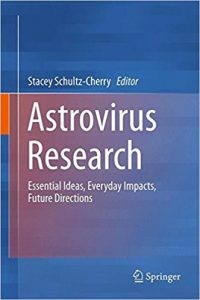Astrovirus Research: Essential Ideas, Everyday Impacts, Future Directions

[amazon template=image&asin=1461447348]
Astroviruses were first identified in the feces of children in 1975. Since then, they have been found in ~ 3 to 20% of children with diarrhea. Given that serological studies have demonstrated that up to 90% of children have been exposed to at least one strain of astrovirus by age 9, the prevalence of infection may be much higher. Supporting this are studies demonstrating that astroviruses can also be isolated in a subset of asymptomatic individuals, suggesting that a proportion of infected individuals shed the virus asymptomatically or for some time after the resolution of other symptoms of infection. Asymptomatic carriers may be a major reservoir for astroviruses in the environment and could contribute to dissemination of the virus. Astroviruses are extremely stable in the environment and can be transmitted nosocomially, directly from infected individuals and potentially animals, and through contaminated food and water. Although typically an acute disease, astrovirus infection in premature infants may be associated with the development of necrotizing enterocolitis and in new-onset celiac disease in children. Immunocompromised children are even more susceptible often developing persistent infections that lead to wasting or even systemic infections associated with fatal encephalitis. In spite of its importance, little is known about astrovirus pathogenesis, molecular biology, epidemiology, or cell biology. The goal of this book is to provide the latest and most up-to-date information on this medically important and rapidly evolving group of viruses. It will include sections on the history of astroviruses and their disease in humans; information on viral replication and immune responses; new information on how astroviruses induce disease including the expression of a viral enterotoxin regulating intestinal epithelial cell tight junctions, the isolation and identification of new astrovirus genotypes in mammals including humans, and astroviruses of veterinary importance. Finally, the book will also introduce the complexity of astrovirus epidemiology and potential as an important new zoonotic disease, and its role in food-borne disease. This will be the first book of its kind and will be of great interest to microbiologists, virologists, infectious disease specialists, immunologists, pediatricians, public health and food safety experts, veterinarians, poultry industry specialists, and researchers and clinicians interested in enteritis.
DOWNLOAD THIS BOOK FREE HERE
http://upsto.re/FqrTGJ2
DISCLAIMER
This website strictly complies with DMCA Digital Copyright Laws..
Please be clear that we (emedicalbooks.com) do not own copyrights of these e-books. The intention behind sharing these books and educational material is to provide easy access to medical students, doctors and other individuals related to the field of medical science, "thus only for educational purpose". We highly encourage our readers to purchase this content from the respected publishers. If anyone holding copyrights wants us to remove this content, please contact us rightaway. All books and educational material on emedicalbooks.com are free and NOT HOSTED ON OUR WEBSITE. If you feel that your copyrights have been violated, then please contact us immediately. You may send an email to emedical1521@gmail.com for all DMCA / Removal Requests. emedicalbooks.com doesn’t have any material hosted on the server of this page, only links to books that are taken from other sites on the web are published and these links are unrelated to the book server. emedicalbooks.com server doesnot store any type of book or material. No illegal copies are made or any copyright © and / or copyright is damaged or infringed since all material is free on the internet.







